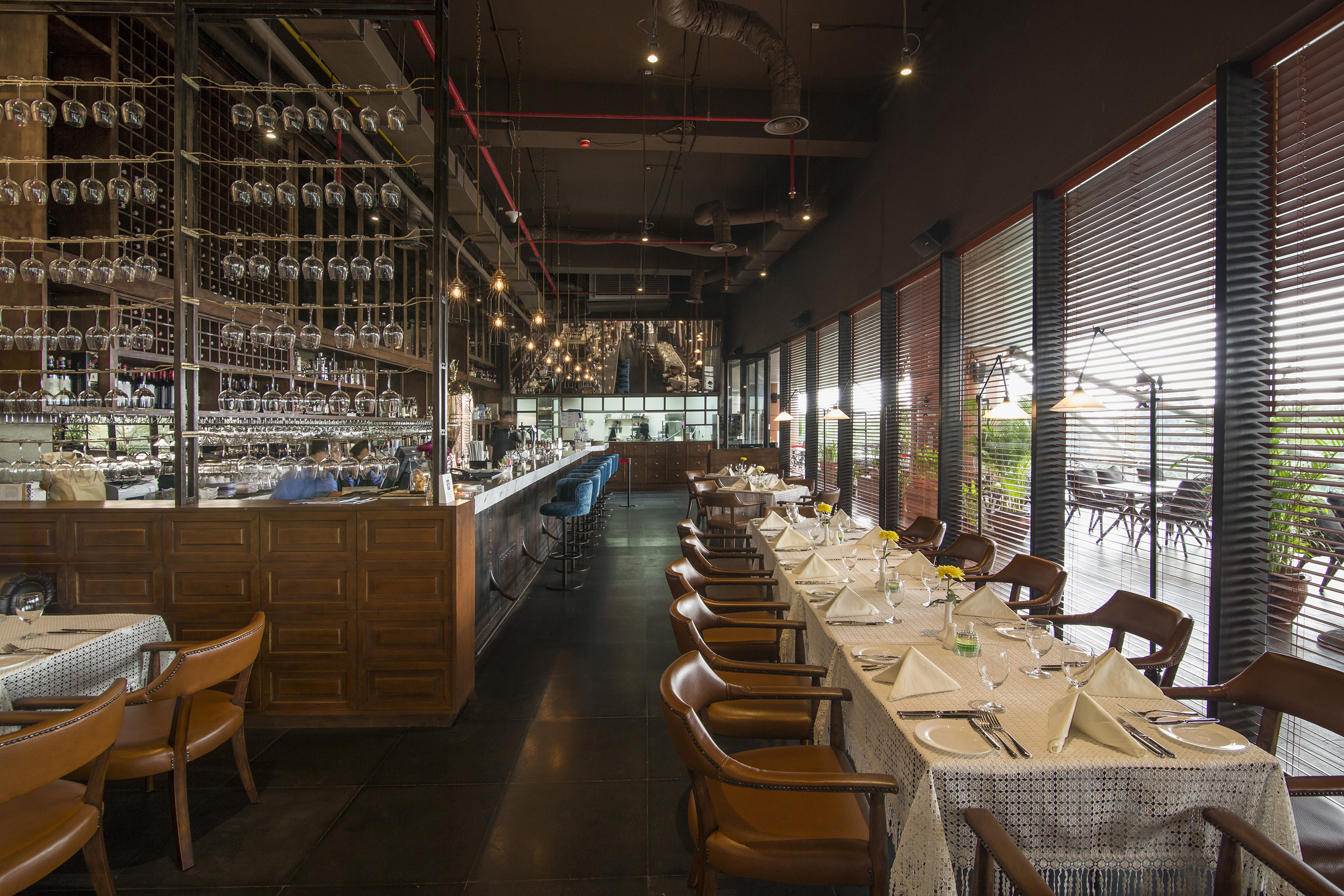While fusion cooking has lost some of its fizz, with certain chefs now abhorring the label, there is much enthusiasm for tinkering with old-world and modern.
The decorative ventilation fans have been rusted to precise antiquity; the screen prints of historical figures on yellowed paper arranged with erratic precision. In playing with opposites, the advantage is in extracting the best from each. Such is the approach of Aceh-born chef Zulkarnain Dahlan, who refutes the “fusion” label even though his Warm Mushroom Salad features a bawang-goreng-and-crushed-walnut garnish over shiitake mushrooms. Likewise, his Deconstructed Pisang Goreng sports a breadcrumb coating drizzled in vol au vent (which, by the way, tastes just like liquefied toffee).
This refusal to be boxed in has spurred Colonial Molecular & Cuisine to adopt the “molecular” method at its bar ahead of its peers. The test tubes and elliptical flasks affixed to lab stands on the marble countertop are used to engineer such peculiarities as the Tequila Sunny-side Up, a cocktail which looks like it belongs on a breakfast plate next to the hash browns. The alcohol is trapped in a membrane created by mixing algae in a calcium solution through a process called spherification to shape the “yolk.” Meanwhile, the “egg white” is merely gelatin that has undergone gelification, in which it is heated to liquid form and cooled, whereby it solidifies in the desired shape. Installing laboratory equipment in kitchens, as the molecular gastronomy movement entails, enables chefs to parlay alterations in the chemical properties of food when it is cooked - hence gutting the rulebook.
A self-professed ‘casual fine dining’ establishment, Colonial’s food and service seem to account for the fine dining half while the1930s-gastro-pub-meets-inner-city-slick decor exudes a more relaxed mien. There is hence the visual illusion of two dining halls from different eras stitched together - an improvisation which also pervades the cuisine.
The Bar de Ligne en Papillote, for instance, uses the decades-old French cooking method to keep airtight the seabass, fennel, asparagus, kalamata olive and cherry tomato while it is steamed in a water bath. The sealant, explained Chef Zul, used to be a pig bladder which would inflate in hot water; nowadays, parchment paper is favored when cooking en papillote. Upon opening, a bell pepper-like odor diffuses, lingering in the air for mere seconds. Imbibing this scent, Chef Zul insists, is inseparable from the sensory experience. The sea bass is relatively bland in concession to the sweetly zesty sauce it swims in: extra virgin olive oil with a blend of white wine and orange juice. Palpable in every bite, the nuttiness of the olives contributes a mint-like bitterness without the menthol. Undoubtedly a nutrient-laden dish but certainly not Colonial’s heartiest.
Fish is better represented in the Homemade Norwegian Smoked Salmon, which, as one of the ‘Plats Speciaux’, uses salmon imported biweekly which Chef Zul marinates for 48 hours in lemon zest, salt and pepper and smokes for another five. Sliced to an immoderate thickness and stuffed with Philly cream cheese, the silkiness of the fresh fish - though slightly over-salted - confers a rich taste that belies the dish’s simplicity. The confetti of diced red onions and the pain de campagne supply a needed crunch where soft textures threaten to override.
The appetizers (les entrées) comprise mostly by-the-book salads - Caesar served with king prawn or smoked chicken, brie and pear salad, seafood salad - but a particular standout was the Warm Mushroom Salad, comprising a beehive-like arrangement of silken baby spinach leaves, shimeji and shiitake mushrooms moistened with a truffle essence that tasted not unlike a thin oyster sauce. The crowning of bawang goreng (fried shallots) further engendered a strong oriental leaning.
“If you want to talk about French cuisine, Italian cuisine, Turkish cuisine - that’s up to you. For me that’s all bulls**t. Seriously. Because nowadays there are no such [distinctions in] cuisine,” said Chef Zul, who helms a restaurant that claims to draw from Indonesian, French and Indian influences.
The Les Viandes (meat) dishes boast the expected array of premium cuts such as Tenderloin à la Rossini; Australian Lamb Rack and Baby Pork Ribs, as well as a full-blood Wagyu “Blackmore” that retails for Rp1,435 million; which, according to Chef Zul, should never be cooked well-done.
“It breaks my heart when [people] order beef well-done. Because all the juices and all the goodness in the beef [go] to the grill. The grill is the one who is happy," he jokes. "You should go eat nasi padang.”
The La Hampe Onglet Steak is served red - with a tender juiciness achieved within a minuscule margin of error. Eaten alone, the meat has a smoky, beef-bacon savoriness - which melds brilliantly with the sweet shallot sauce on the side. Equilibrium of sweet, smoky and spicy is slightly upset by a little too much black pepper in the sauce, but the flavor of the beef and the whipped cream-soft mashed potatoes - although a mere decorative slick on the edge of the plate - redeems the dish.
The desserts don’t ring distinctly French - mainstays include profiteroles, truffle crème brulée, Assiette de Fromages (a 3-cheese platter), punctuated by Japanese ice cream and the delicious Deconstructed Pisang Goreng. Even the soufflé is served with an apple sorbet rather than the customary vanilla ice cream - just for differentiation. “The second reason is because chocolate-based soufflé is heavy so if you give vanilla ice cream, the sweetness impresses heaviness. That’s why I give you a sorbet,” explained Chef Zul.
With its brazen attempt to reconcile opposites - vintage and modern, uncharted molecular experimentation and classic techniques - Colonial Molecular & Cuisine shows that with apt execution there is no such thing as paradox.

